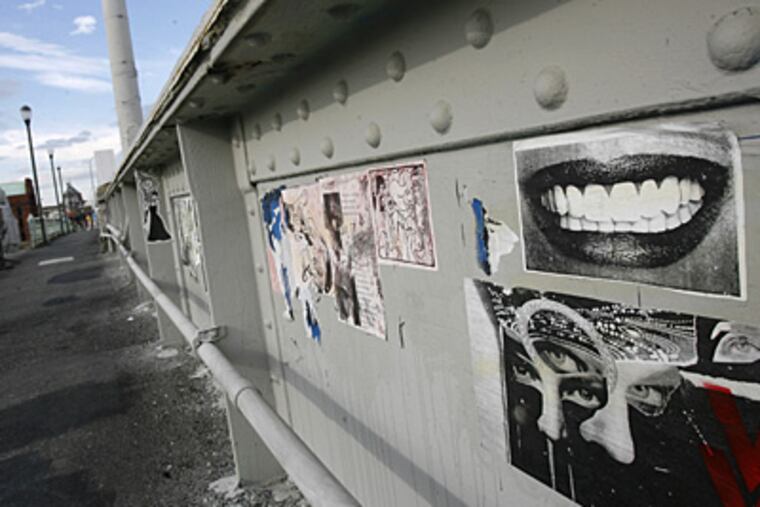Speeding cars, fleeting art
When the old South Street Bridge vanishes, so disappears a secret public canvas of real outsider art. Illegal, yes - inspiring, absolutely.

Chances are no mourners will gather at the foot of the South Street Bridge tomorrow when the wrecking ball arrives. The decrepit 85-year-old span will close to traffic, and demolition will begin almost immediately, according to the city. A new bridge is to open two years, and $67.5 million, from now.
Aside from some modestly ornamental ironwork, the bridge has led a utilitarian existence, and the idea of replacing it with something of greater structural integrity strikes commuters between West Philadelphia and Center City as a sensible move.
But for decades the South Street Bridge has also had a secret life - as the city's largest public canvas. The broad, waist-high metal sections that separate pedestrians from traffic have served over the years as exhibition space for spontaneous acts of art.
Some of it is political, some of it not. About 15 years ago an ephemeral, large-print poem appeared, a surprisingly naked and public lament on loneliness. During the peak of anger over the war in Iraq, you could find tiny pink plastic soldier figures glued to various spots on the bridge. Anti-Bush posters gathered here, and other pieces of protest, their messages more obscure, bloomed along the path.
Pure art, too - more or less in the style of the elusive British street artist Banksy, the late Keith Haring, and others - found an indigenous home. Like the rose that blooms from a crack in the sidewalk, this art packed a unique joy. It was unexpected and opportunistic.
Best of all, it was totally unsponsored - un-encouraged, even. Philadelphia, like cities from Sydney to Cleveland, has spent billions of dollars erecting buildings to cultivate the arts. Among the big expenditures of the last two decades: $500 million for the Kimmel Center (including building, endowment, renovations to come); $600 million for renovation and expansion at the Philadelphia Museum of Art; more than $150 million for the Barnes.
But the South Street Bridge showed that while good acoustics and climate control are nice, they do not define art. Some art needs a wall; some just needs, well, nothing. Not even longevity.
"Portions of the bridge have been periodically painted over by the city's anti-graffiti crews (including posters and advertising). None of this is permitted on city infrastructure and is illegal," Rina Cutler, deputy mayor for transportation and utilities, said in an e-mail.
And yet it kept on coming.
The South Street Bridge was in many ways a reminder of what art was before it was appropriated for economic development, for tourism, before it gathered about it that dulling chamber-of-commerce packaging that presents art in a generic, prescribed way. There are no images of storybook ballerinas and white-at-the-temples maestros, no van Gogh sunflowers. There's no gift shop, no tour bus, no audio guide. Nothing here will sell at Sotheby's for an unspeakable sum and end up over a sofa in the Hamptons or Dubai.
In fact, with cars whizzing by on one side and the muddy Schuylkill on the other, you have to stay focused to examine these anonymous statements. The Philadelphia Museum of Art is luring visitors with shows that bring "outsider art in," but this outsider art is decidedly out. That it wasn't supposed to happen at all adds its own verboten gilt-edged framing.
Even with the closing imminent, the city in recent months has removed much of it. By mid-November only a few examples remained, but they are striking and potent. Will someone save them for posterity, or is their perishable state part of the appeal?
Is it graffiti? Of course. Is it illegal? Yes. But it's a lot like the skateboarders in LOVE Park, or the singer-songwriters and the ad hoc string quartets from the Curtis Institute that spring up in Rittenhouse Square. The city wants urban vitality. It has spent billions encouraging it. And here it is - "authentic," high praise in art-criticism parlance. Isn't there an important distinction to be drawn between graffiti as an act of destruction and graffiti as an act of creation? Noise whose aim is disruption and noise whose purpose is meaningful distraction? Adjudicating the distinction just isn't that hard.
Now there's no need to try. Demolition begins tomorrow, and Cutler said the city wouldn't tolerate art on the South Street Bridge's successor: "One person's art is another person's graffiti."
Quality is subjective, of course, though I suspect the city would take the same position if Thomas Eakins rose from the dead and headed up South Street brandishing a full set of Winsor & Newton hog brushes. The art on the bridge in the last few months comes mostly in paper form, preprinted, perhaps hand-colored and pasted up. Some is sprayed on with stencil. Painting, photography and graphics form pastiches, their messages jumbling into an aesthetic echoed by, among others, Nike in its latest ads on the Broad Street subway.
And if you want to start a conversation about politics, war or religion with your 8-year-old, there's no better shortcut than a walk across this bridge. You have only a few more hours to test the idea.
Guerrilla art exists elsewhere - on honor boxes on Ellsworth Street in South Philadelphia, on the back of stop signs near South Street, in cunning, punchy graphic strokes all over Northern Liberties. But none of these spots offers the concentration of a single canvas - a living, changing piece of stop-motion animation with a city skyline thrown in, no extra charge.